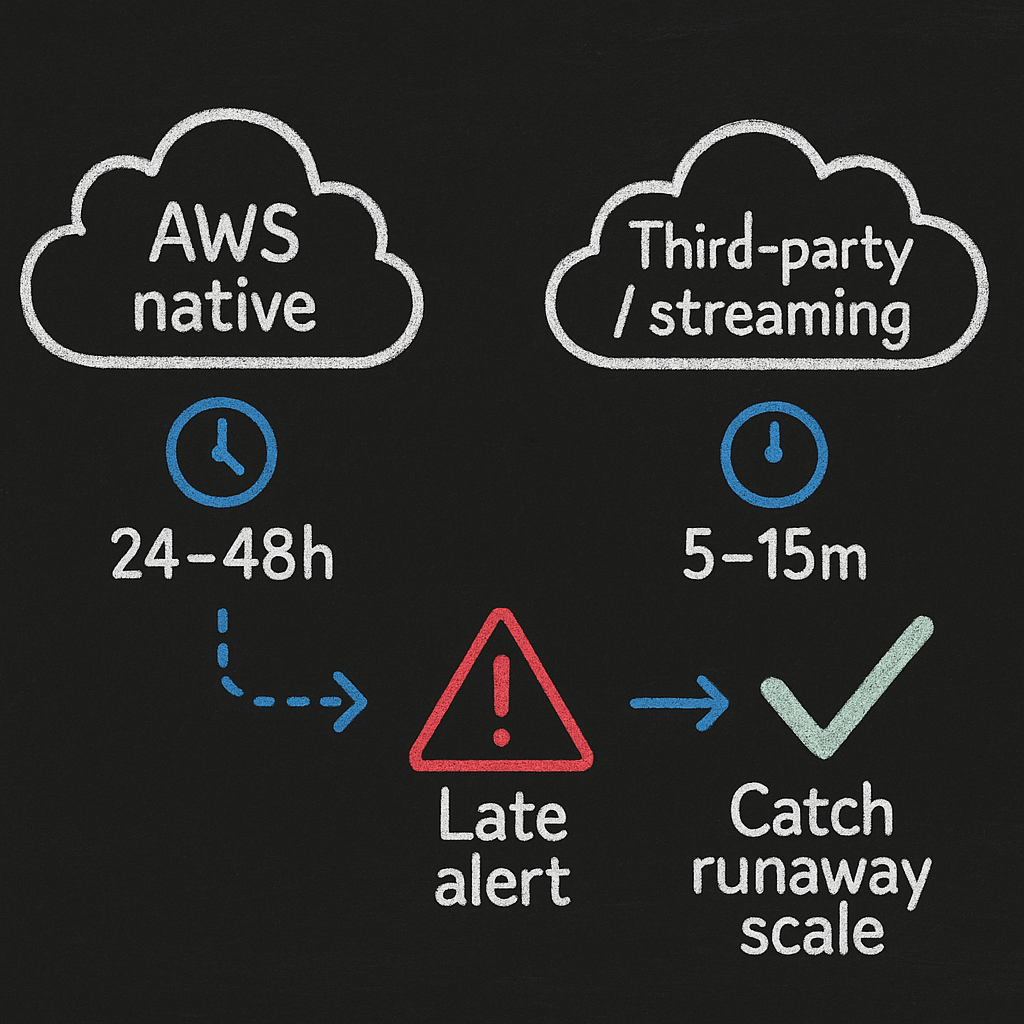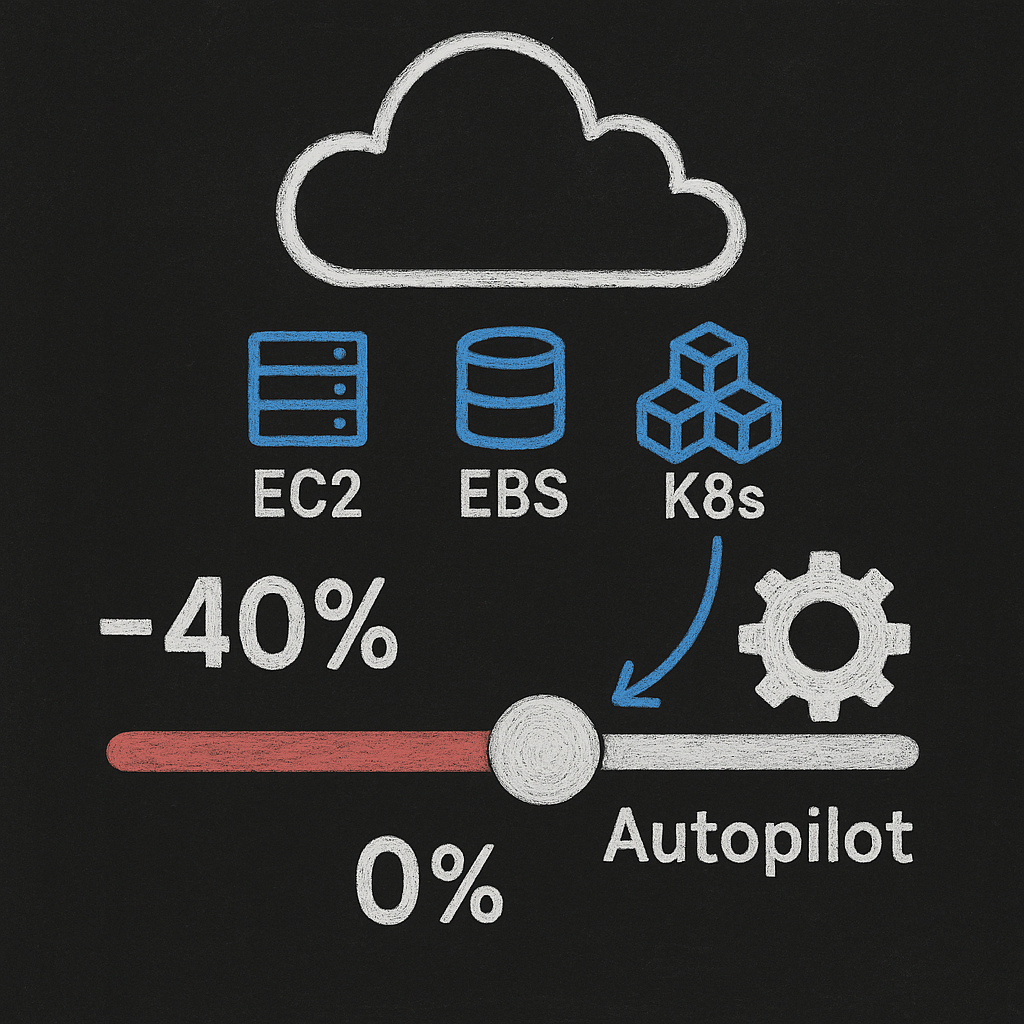AWS cost monitoring with autopilot savings and clarity
If your AWS bill can jump 25% overnight, waiting 24–48 hours to see it is too late. Here’s how finance and engineering teams get near real-time visibility—and lock in up to 40% savings on autopilot.
What “real-time” AWS cost monitoring really means
Native AWS tools update slowly. AWS Cost Explorer typically lags by 24–48 hours, which is fine for trends but not for daily operational decisions. The most granular native dataset (AWS Cost and Usage Reports, CUR) is hourly but still requires 24+ hours for delivery and processing.
Anomaly Detection offers helpful alerts, but latency ranges from 2–24 hours. Near real time is feasible. Third-party platforms can achieve 5–15 minute visibility using streaming collectors and purpose-built pipelines. That’s the difference between catching runaway auto-scaling before lunch versus after the invoice.

Hykell at a glance: autopilot savings, guaranteed
40% savings, guaranteed. Hykell delivers automated cost optimization across EC2, EBS, and Kubernetes, with a 40% reduction guarantee when conditions are met (workload dependent, typical 6-month commitment) backed by case results of 30–50% reductions.

Key capabilities:
- Near real-time monitoring (5–10 minutes) and cost anomaly visibility
- EC2 right-sizing, EBS gp2→gp3 migrations, and storage tiering automation
- Kubernetes cost optimization that eliminates “resource inflation” (often 30–50% cluster waste)
- Rate optimization through Savings Plans/Reserved Instances coverage modeling
- Comprehensive cost audits that uncover hidden waste and tag gaps
Business model: Hykell only takes a slice of what you save—if you don’t save, you don’t pay. Explore more at hykell.
Your options: native AWS, open source, and managed platforms
1. Native AWS tools (free, slower data)
Cost Explorer: Historical spend, service breakdowns, and basic forecasting with 24–48 hour latency. Great for trend analysis; not operationally real-time.
CUR + Athena: Most granular billing data (hourly) for custom analysis; setup requires S3, Athena, and partitioning.
AWS Budgets: Threshold-based alerts, daily at best; can integrate to remediate via Lambda, but not out of the box.
Compute Optimizer: Rightsizing insights for EC2, EBS, Lambda, Aurora; useful but not real-time enforcement.
2. Open source (flexible, engineering-led)
Kubernetes visibility via projects like OpenCost and Kubecost, and resource discovery with Komiser, with near real-time pod/namespace breakdowns. See our guide on open source cloud cost management for pros, cons, and a practical stack (e.g., Karpenter + OpenCost + Grafana).
3. Managed cost optimization platforms (near real time, automated)
Third-party platforms provide 5–15 minute data freshness, cross-account coverage, Kubernetes cost allocation, policy-driven optimization, and governance. Hykell layers proactive automation on top, operating savings on autopilot while keeping performance and compliance intact.
Step-by-step: monitor, forecast, and optimize AWS spend
Step 1 — Establish data foundations (Day 1–3)
Enable CUR delivery to S3 with resource IDs and cost allocation tags; verify S3 permissions to avoid delivery failures.
Standardize tagging early (owner, env, app, cost-center). Untagged spend typically runs 15–30%; mature FinOps targets <5%.
For multi-account orgs, consolidate billing with AWS Organizations and align tag policies across accounts.
Step 2 — Build near real-time visibility (Day 3–7)
Create live dashboards: daily burn, cost by service/account/tag, Kubernetes cost per cluster/node. Aim for 5–15 minute refresh where possible.
Set baselines and KPIs:
- Daily burn-rate variance: alert at >15% vs forecast
- Untagged spend %: keep below 5%
- Prod vs non-prod ratio: target non-prod <35%
- Exec metric: Monthly run rate vs forecast variance
Step 3 — Forecast with confidence (Week 2)
Use Cost Explorer forecasts for 1–3 month horizons on stable workloads (good directional signal despite latency) and overlay committed coverage (Savings Plans/RI) for net run-rate. Document variance drivers weekly.
For executive readouts, report run rate (annualized), forecast, and variance with driver commentary.
Step 4 — Alerting and anomaly detection (Week 2)
Configure AWS Budgets for layered thresholds (warning at 10% variance, critical at 25%) to prevent alert fatigue.
Enable AWS Cost Anomaly Detection after you have 2+ months of history; tune sensitivity to your normal seasonality.
Route alerts to Slack/Email and, where appropriate, auto-remediate via Lambda (e.g., scale down rogue ASGs in dev) as described in our aws cost management best practices.
Step 5 — Optimize continuously (Week 3 onward)
Quick wins:
- Right-size EC2 based on utilization and Compute Optimizer to save 10–20% or more.
- EBS optimization: migrate gp2→gp3, right-size volumes; typical 20–30% savings and real-world cases saving thousands monthly.
- Storage tiering: S3 lifecycle policies and Glacier Deep Archive often cut archival storage by 80%+.
- Schedule non-prod environments off-hours to reduce compute by 65%+.
Pricing model optimization:
- Savings Plans up to 72% and Reserved Instances up to 75% for predictable workloads—ensure 70%+ utilization to beat on-demand.
- Spot Instances up to 90% savings for fault-tolerant jobs; architect for interruption.
Kubernetes efficiency:
- Address “resource inflation” with requests/limits tuning, bin-packing, and autoscaling; 30–50% savings are common.
Governance:
- Quarterly cross-functional cost reviews are a FinOps best practice to sustain gains.
- Use the cloud cost audit checklist to benchmark maturity and uncover hidden waste.
Common pitfalls that spike AWS bills
- Unmonitored data transfer between regions/AZs
- Unrestricted auto-scaling in dev/test
- Unoptimized storage tiers and zombie snapshots
- Untagged resources that can’t be allocated back to owners
- Region choice misaligned with cost/performance targets (prices vary ~40% by region)
People also ask: quick answers
What is Cost Management tool in AWS?
It’s a suite of native services—Cost Explorer, CUR, AWS Budgets, Anomaly Detection, Compute Optimizer—used to visualize, allocate, forecast, and control spend.
What is the AWS costing tool?
For pre-deployment estimates, use the AWS Pricing Calculator. For post-deployment analysis, use Cost Explorer and CUR.
What is the AWS cost optimization program?
It refers to AWS guidance and tooling (Well-Architected Cost Optimization Pillar, Compute Optimizer, Savings Plans/RI) that help you design and operate cost-efficient architectures.
What is the difference between AWS TCO and Cost Explorer?
TCO calculators estimate costs for migration/planning; Cost Explorer analyzes actual spend and usage post-deployment with 24–48 hour latency.
How to track costs in AWS?
Enable CUR, standardize tags, create Cost Explorer views, set up Budgets and Anomaly Detection, and implement near real-time dashboards. Our aws cost management best practices article details each step.
Which AWS tool is used for visualizing the cost usage of AWS services?
AWS Cost Explorer is the native visualization tool; for Kubernetes and granular pod-level views, see our guide to open source cloud cost management.
How to calculate AWS cloud cost?
Use the AWS Pricing Calculator for estimates, then validate with CUR-based reporting for actuals. For optimization potential, try Hykell’s savings assessment.
What is the AWS cost forecasting tool?
Cost Explorer includes built-in short-horizon forecasting; complement it with your own models and committed spend coverage for accuracy.
How do I monitor AWS costs?
Combine Budgets and Anomaly Detection with near real-time dashboards. For automated optimization and 5–10 minute visibility, consider hykell.
How do I see my current costs on AWS?
Go to the Billing console and Cost Explorer; for finer granularity, query CUR in Athena. Note native data can lag up to 48 hours.
When to move beyond native tools
- You need sub-hour visibility to stop runaway costs the same day
- You run EKS and want namespace/pod/cluster costs with engineering guardrails
- You want automated enforcement (scheduling, right-sizing, storage tiering) instead of manual ticketing
- You want a 40% savings guarantee with “no save, no fee” alignment—see hykell
Best practices that keep savings durable
Get tagging to <5% untagged within 30 days for true accountability.
Start with storage and scheduling for fast wins: lifecycle policies often yield 20–80% savings; non-prod schedules save 65%+ hours.
Use commitment discounts wisely; model utilization to avoid overcommit.
Bake cost into performance work. Right-sizing EC2 and EBS often improves both performance and cost—see our guides on aws ec2 performance tuning and aws rds mysql performance tuning. Align with service guarantees via the aws performance sla.
Review trends quarterly and adjust strategy with engineering + finance; FinOps maturity grows from crawl to run via consistent collaboration and staying current on cloud optimization trends.
Why Hykell for AWS-finance and engineering teams
Real-time cost clarity: near real-time insights across accounts, services, and Kubernetes.
Automatic optimization: EC2/EBS right-sizing, storage tiering, non-prod schedules, and rate optimization—without extra engineering cycles.
Kubernetes-first view: cost per cluster/node/namespace with policy guardrails to eliminate resource inflation.
Audit to action: detailed findings to executive reports, variance analysis, and change tracking so finance sees forecast improvements, not just technical recommendations.
Proof, not promises: See the methodology and results in our case studies and start with a frictionless audit using the cloud cost audit checklist.
Make your next AWS decision with data you can act on today. Try our savings calculator to see your potential 25–40% reduction—or start a cost audit and let Hykell run the optimizations on autopilot.
Calculate savings now: hykell.com/assessment Or begin a zero-risk audit: hykell
Further reading
- AWS Cost Explorer overview
- AWS Cost and Usage Reports
- AWS Well-Architected Cost Optimization Pillar
- FinOps Framework and forecasting guidance
- Gartner on cloud cost overruns and tooling importance
Related Hykell resources
- Start with aws cost management best practices to build your operating model
- Explore cloud cost optimization tools gartner for selection criteria and automation value
- Evaluate open source cloud cost management if you prefer self-hosted visibility before automation
